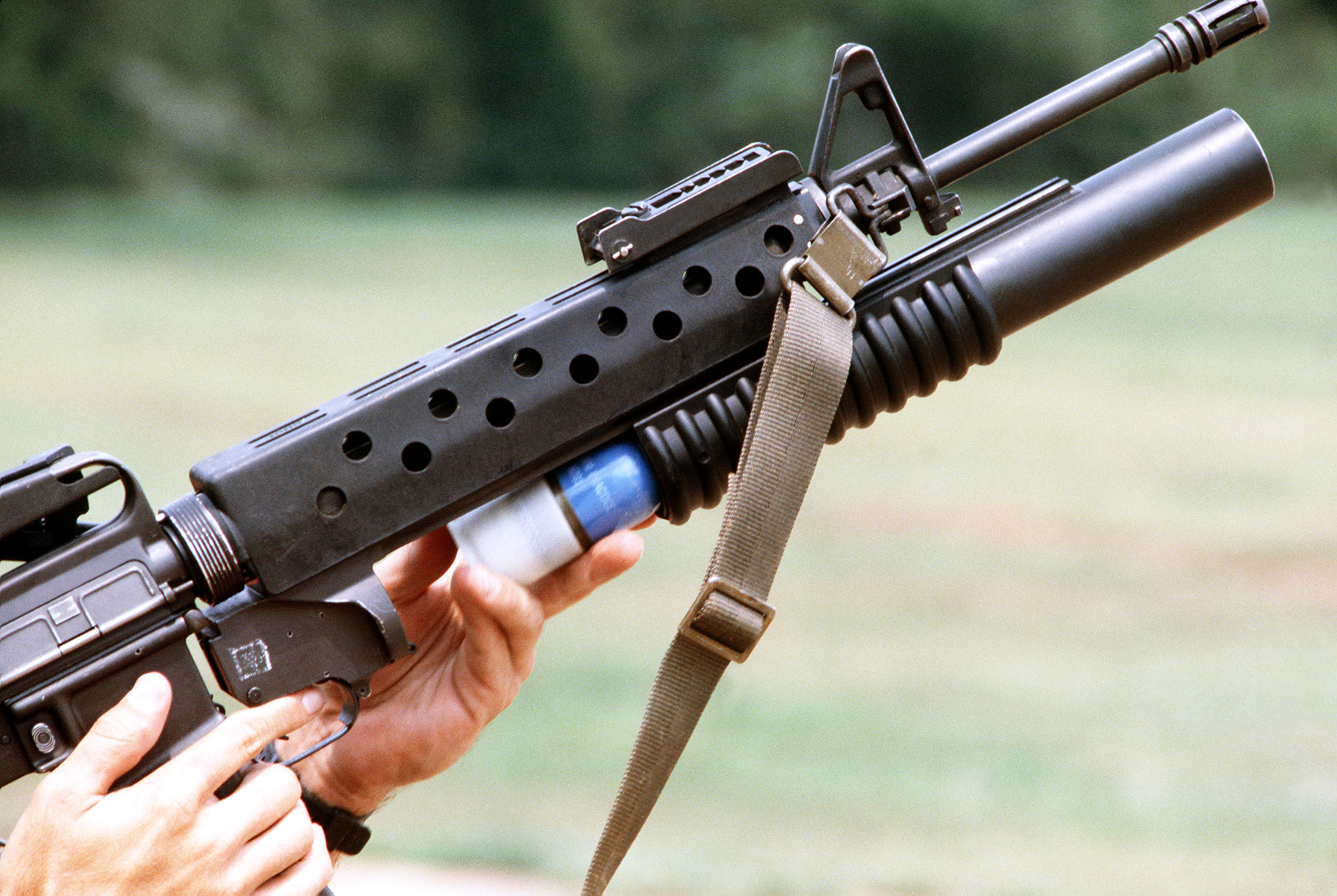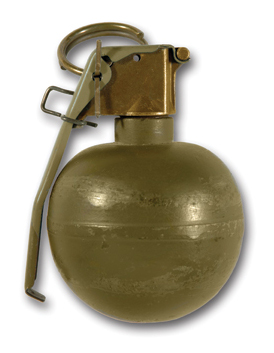|
Pallad Grenade Launcher
The Pallad (also known as the wz. 1974) is a 40 mm Polish underslung grenade launcher, developed for use with the AKM assault-rifle and intended to replace the kbkg wz. 1960 grenade-launcher rifle. The name of the weapon reflects the Polish-language word for palladium Palladium is a chemical element with the symbol Pd and atomic number 46. It is a rare and lustrous silvery-white metal discovered in 1803 by the English chemist William Hyde Wollaston. He named it after the asteroid Pallas, which was itself na .... The development of the weapon drew on concepts provided by Józef Brodacki. The wz. 1983 Pallad D, the stand-alone version of the wz. 74, features a stock and AK type pistol grip. There are also variants compatible with 40x46mm NATO named GP-40 (40x46mm version of wz. 74 Pallad) and GS-40 (40x46mm version of wz. 83 Pallad-D). Users * – 10 (''5,56mm'' karabinek-granatnik wz. 1974) were given from Poland and in use by Lithuania before 2003 * – ''7,62mm'' ... [...More Info...] [...Related Items...] OR: [Wikipedia] [Google] [Baidu] |
Polish People's Republic
The Polish People's Republic ( pl, Polska Rzeczpospolita Ludowa, PRL) was a country in Central Europe that existed from 1947 to 1989 as the predecessor of the modern Republic of Poland. With a population of approximately 37.9 million near the end of its existence, it was the second-most populous communist and Eastern Bloc country in Europe. It was also one of the main signatories of the Warsaw Pact alliance. The largest city and official capital since 1947 was Warsaw, followed by the industrial city of Łódź and cultural city of Kraków. The country was bordered by the Baltic Sea to the north, the Soviet Union to the east, Czechoslovakia to the south, and East Germany to the west. The Polish People's Republic was a socialist one-party state, with a unitary Marxist–Leninist government headed by the Polish United Workers' Party (PZPR). The country's official name was the "Republic of Poland" (') between 1947 and 1952 in accordance with the transitional Small Constitutio ... [...More Info...] [...Related Items...] OR: [Wikipedia] [Google] [Baidu] |
Zakłady Mechaniczne Tarnów
Zakłady Mechaniczne Tarnów ( en, Tarnów Mechanical Works; ) is a Polish defense manufacturing company. Based in the city of Tarnów, the company produces handguns, assault rifles, sniper rifles and anti-air guns. It is part of the Bumar-Labedy corporation, itself a division of the state-controlled Polish Armaments Group. History Initially founded during World War I in 1917 as a local train repair workshop, in the interwar period the company was part of the Polish State Railways. After the company's equipment was confiscated, dismantled and sent to Germany during World War II, the factory was rebuilt as a train repair workshop, but in 1951 it was turned into a defence contractor producing guns, firearms and machine tools. Warsaw Pact years From 1951 the company license-built M1939 37 mm automatic air defense guns and Nudelman N-37 aircraft cannons used in LiM-2 and MiG-17 fighters. While Poland was still in the Warsaw Pact, other types of Soviet-designed military equipment we ... [...More Info...] [...Related Items...] OR: [Wikipedia] [Google] [Baidu] |
40 Mm Grenade
40 mm grenade (also styled 40mm grenade) is a generic class-name for grenade launcher ammunition ( subsonic shells) in caliber. The generic name stems from the fact that several countries have developed or adopted grenade launchers in 40 mm caliber. This is a general collection of the world's many different "40 mm grenades". NATO NATO currently uses three standardized 40 mm grenade families: 40 mm low velocity (LV), 40 mm medium velocity (MV), and 40 mm high velocity (HV). Low- and medium-velocity cartridges are used for different hand-held grenade launchers, while the high-velocity cartridge is used for automatic grenade launchers. 40×46 mm LV (40 mm low velocity) ''40×46 mm LV'' (''low velocity'') is a NATO-standard high–low grenade launcher cartridge meant for hand-held grenade launchers, such as the M79, M203, Milkor MGL, and Heckler & Koch AG36. The propellant has low pressure and gives the projectile an average velocity of depending on the ammuniti ... [...More Info...] [...Related Items...] OR: [Wikipedia] [Google] [Baidu] |
Grenade Launcher Wz
A grenade is an explosive weapon typically thrown by hand (also called hand grenade), but can also refer to a Shell (projectile), shell (explosive projectile) shot from the muzzle of a rifle (as a rifle grenade) or a grenade launcher. A modern hand grenade generally consists of an explosive charge ("filler"), a detonator mechanism, an internal Firing pin, striker to trigger the detonator, and a safety lever secured by a split pin, cotter pin. The user removes the safety pin before throwing, and once the grenade leaves the hand the safety lever gets released, allowing the striker to trigger a Percussion cap, primer that ignites a fuze (sometimes called the delay element), which burns down to the detonator and explodes the main charge. Grenades work by dispersing fragments (fragmentation grenades), shockwaves (High explosive, high-explosive, Anti-tank grenade, anti-tank and stun grenades), chemical aerosols (Smoke grenade, smoke and gas grenades) or fire (incendiary grenades). Fr ... [...More Info...] [...Related Items...] OR: [Wikipedia] [Google] [Baidu] |
Grenade Launcher
A grenade launcher is a weapon that fires a specially-designed large-caliber projectile, often with an explosive, smoke or gas warhead. Today, the term generally refers to a class of dedicated firearms firing unitary grenade cartridges. The most common type are man-portable, shoulder-fired weapons issued to individuals, although larger crew-served launchers are issued at higher levels of organisation by military forces. Grenade launchers can either come in the form of standalone weapons (either single-shot or repeating) or attachments mounted to a parent firearm, usually a rifle. Larger crew-served automatic grenade launchers such as the Mk 19 are mounted on tripods or vehicles. Some armored fighting vehicles also mount fixed arrays of short range, single-shot grenade launchers as a means of defense. History Early precursors The earliest devices which could be referred to as grenade launchers were slings, which could be used to throw early ''grenado'' fuse bombs. The a ... [...More Info...] [...Related Items...] OR: [Wikipedia] [Google] [Baidu] |
Kbkg Wz
KBKG (93.5 FM) is a radio station broadcasting a classic hits format, licensed to Corning, Arkansas Corning is a city in Clay County, Arkansas, United States. The population was 3,377 at the 2010 census. It is one of the two county seats of Clay County, along with Piggott. History The original settlement was approximately one mile east and was ..., United States. The station is currently owned by Shields-Adkins Broadcasting. The station has obtained a construction permit from the FCC for a power increase to 12,000 watts. References External links Official Website* BKG {{Arkansas-radio-station-stub ... [...More Info...] [...Related Items...] OR: [Wikipedia] [Google] [Baidu] |
Polish Language
Polish (Polish: ''język polski'', , ''polszczyzna'' or simply ''polski'', ) is a West Slavic language of the Lechitic group written in the Latin script. It is spoken primarily in Poland and serves as the native language of the Poles. In addition to being the official language of Poland, it is also used by the Polish diaspora. There are over 50 million Polish speakers around the world. It ranks as the sixth most-spoken among languages of the European Union. Polish is subdivided into regional dialects and maintains strict T–V distinction pronouns, honorifics, and various forms of formalities when addressing individuals. The traditional 32-letter Polish alphabet has nine additions (''ą'', ''ć'', ''ę'', ''ł'', ''ń'', ''ó'', ''ś'', ''ź'', ''ż'') to the letters of the basic 26-letter Latin alphabet, while removing three (x, q, v). Those three letters are at times included in an extended 35-letter alphabet, although they are not used in native words. The traditional ... [...More Info...] [...Related Items...] OR: [Wikipedia] [Google] [Baidu] |
Palladium
Palladium is a chemical element with the symbol Pd and atomic number 46. It is a rare and lustrous silvery-white metal discovered in 1803 by the English chemist William Hyde Wollaston. He named it after the asteroid Pallas, which was itself named after the epithet of the Greek goddess Athena, acquired by her when she slew Pallas. Palladium, platinum, rhodium, ruthenium, iridium and osmium form a group of elements referred to as the platinum group metals (PGMs). They have similar chemical properties, but palladium has the lowest melting point and is the least dense of them. More than half the supply of palladium and its congener platinum is used in catalytic converters, which convert as much as 90% of the harmful gases in automobile exhaust (hydrocarbons, carbon monoxide, and nitrogen dioxide) into nontoxic substances (nitrogen, carbon dioxide and water vapor). Palladium is also used in electronics, dentistry, medicine, hydrogen purification, chemical applications, groundwate ... [...More Info...] [...Related Items...] OR: [Wikipedia] [Google] [Baidu] |
Polish Land Forces
The Land Forces () are the land forces of the Polish Armed Forces. They currently contain some 62,000 active personnel and form many components of the European Union and NATO deployments around the world. Poland's recorded military history stretches back a millennium – since the 10th century (see List of Polish wars and History of the Polish Army). Poland's modern army was formed after Poland regained independence following World War I in 1918. History 1918–1938 When Poland regained independence in 1918, it recreated its military which participated in the Polish–Soviet War of 1919–1921, and in the two smaller conflicts ( Polish–Ukrainian War (1918–1919) and the Polish–Lithuanian War (1920)). Initially, right after the First World War, Poland had five military districts (1918–1921): * Poznań Military District (Poznański Okręg Wojskowy), HQ in Poznań * Kraków Military District (Krakowski Okręg Wojskowy), HQ in Kraków * Łódź Military District (Łód ... [...More Info...] [...Related Items...] OR: [Wikipedia] [Google] [Baidu] |
40×47mm Grenade Launchers
4 (four) is a number, numeral and digit. It is the natural number following 3 and preceding 5. It is the smallest semiprime and composite number, and is considered unlucky in many East Asian cultures. In mathematics Four is the smallest composite number, its proper divisors being and . Four is the sum and product of two with itself: 2 + 2 = 4 = 2 x 2, the only number b such that a + a = b = a x a, which also makes four the smallest squared prime number p^. In Knuth's up-arrow notation, , and so forth, for any number of up arrows. By consequence, four is the only square one more than a prime number, specifically three. The sum of the first four prime numbers two + three + five + seven is the only sum of four consecutive prime numbers that yields an odd prime number, seventeen, which is the fourth super-prime. Four lies between the first proper pair of twin primes, three and five, which are the first two Fermat primes, like seventeen, which is the third. On the other ha ... [...More Info...] [...Related Items...] OR: [Wikipedia] [Google] [Baidu] |
Grenade Launchers Of Poland
A grenade is an explosive weapon typically thrown by hand (also called hand grenade), but can also refer to a shell (explosive projectile) shot from the muzzle of a rifle (as a rifle grenade) or a grenade launcher. A modern hand grenade generally consists of an explosive charge ("filler"), a detonator mechanism, an internal striker to trigger the detonator, and a safety lever secured by a cotter pin. The user removes the safety pin before throwing, and once the grenade leaves the hand the safety lever gets released, allowing the striker to trigger a primer that ignites a fuze (sometimes called the delay element), which burns down to the detonator and explodes the main charge. Grenades work by dispersing fragments (fragmentation grenades), shockwaves (high-explosive, anti-tank and stun grenades), chemical aerosols (smoke and gas grenades) or fire (incendiary grenades). Fragmentation grenades ("frags") are probably the most common in modern armies, and when the word ''grenade ... [...More Info...] [...Related Items...] OR: [Wikipedia] [Google] [Baidu] |



.jpg)
2.jpg)


